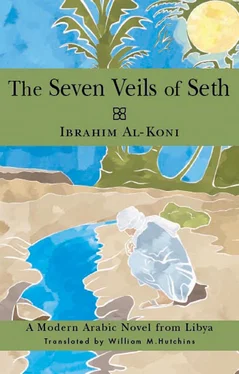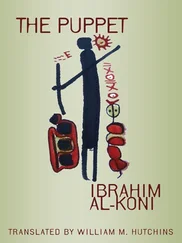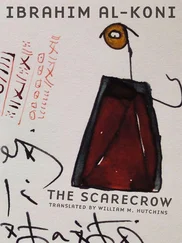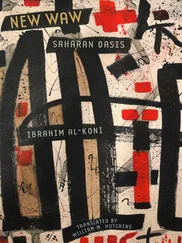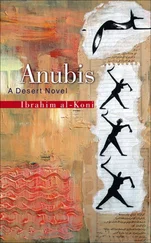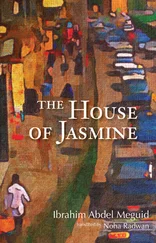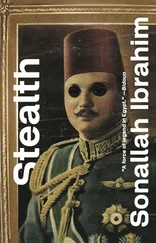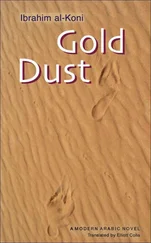Ibrahim al-Koni’s works have already become the subject of papers at scholarly conferences and of M.A. theses in various parts of the world. Awarded a Libyan state prize for literature and art in 1996, he has received prizes in Switzerland in 1995, 2001, and 2005 for his books as well as the literary prize of the Canton of Bern. He was awarded a prize from the Franco-Arab Friendship Committee in 2002 for L’Oasis cachée .
The Tuareg are pastoral nomads who speak Tamasheq, a Berber language written in an ancient alphabet and script called Tifinagh. They are distributed through desert and Sahel regions of parts of Libya, Algeria, Mali, Niger, and Nigeria. An estimate from 1996 put their numbers at one million and a half. Their affiliation with Islam has been enriched by a vibrant mythology and folklore, which Ibrahim al-Koni links with that of ancient Egypt. The Tamasheq language is also related to ancient Egyptian. The goddess Tanit, revered in ancient Carthage, was once worshiped by the Tuareg along with the male sun god Ragh. Traditional Tuareg society has been marked by caste divisions between nobles, vassals, blacksmiths, and slaves. Tuareg men are famous for wearing veils. Women do not normally wear veils but have head-cloths.
Ibrahim al-Koni has made a name for himself in contemporary Arabic literature, even though he is an outsider, a Tuareg who began life as a nomad. His works are remarkable for telling tales that blend folklore, ancient myths, and vivid descriptions of daily desert and oasis life with existential questions that directly challenge the reader.
The translator acknowledges appreciatively the author’s patience and continued trust as well as a literary translation grant from the U.S. National Endowment for the Arts for this novel for the period 2005–2006.
The publisher would like to thank Moneera Al-Ghadeer, Marilyn Booth, Yasir Suleiman and Muhsin al-Musawi for their generous and invaluable advice and assistance in putting together this series, which would not have been possible without their support.
Isan, also known as Seth, the jenny master, Wantahet, and the strategist: a desert wanderer
Ewar, chief or headman of the descent group living at the oasis
Edahi, oasis fool or idiot
Elelli, oasis sage
Yazzal, oasis diviner
Amghar, chief merchant of the oasis
Emmar, oasis warrior
The Six Belles or Water Nymphs:
Taddikat, spouse of Yazzal
Tafarat, spouse of Amghar
Tahala, spouse of Elelli
Tamanokalt, spouse of Ewar
Tamuli, spouse of Emmar
Temarit, sweetheart of Edahi
These two series of generations accordingly, the one of Cain, the other of Seth, represent the two cities in their distinctive ranks, the [latter] one the heavenly city, which sojourns on earth, the other the earthly, which gapes after earthly joys, and grovels in them as if they were the only joys.
Augustine, City of God, 15:15
Since God is the highest good, He would not allow any evil to exist in His works, unless His omnipotence and goodness were such as to bring good even out of evil.
Augustine, Enchiridion, XI
This is part of the infinite goodness of God, that He should allow evil to exist, and out of it produce good.
Thomas Aquinas, Summa Theologica, Q. 2, Art. 3, Reply Objection 1
I declare that I know not which is preferable — a disadvantage which proves to be a benefit, or an advantage which proves to be a hindrance.
Michelangelo, [“To Pope Clement VII in Rome,” January 1524] The Letters of Michelangelo1
PART I Section 1: The Visitor
The shadowy figures of travelers, who might bring either rain or harm to the community, always seemed portentous. So they consulted the diviner about the newcomer’s intentions, even before concern spread through the oasis, but the diviner — in a way typical of this miserable fraternity who are unable to satisfy people’s curiosity, even though people cannot dispense with them — merely sparked more curiosity with his murky sayings, which resembled riddles and puzzles.
The inhabitants of the oasis would not have been skeptical about the stranger’s doings, had he not aroused their suspicions with his conduct, for normally they hastened to welcome visitors and to shower them with displays of generosity, commencing with the slaughter of livestock, continuing with evening festivities, and concluding by shackling them with marriage to their daughters. They had attempted to employ the same ruses with this suspect wayfarer. Eventually they dispatched the fool, in the hope of obtaining a reading on the situation, since they had adopted the ancient tradition of utilizing a fool as their trusted messenger. They were convinced that strangers are by nature mysterious, secretive individuals, who conceal more than they reveal. Otherwise, they would never have set out across the deserts and would never have chosen to join the ranks of foreigners. Whenever their fools failed, they sent a sage. If he failed as well, they dispatched to the cunning fellow the scion of all the cunning of the oasis and perhaps of the entire desert: the diviner.
The stranger outwitted the entire string of investigators this time, however, thus increasing the apprehensions of the people and the anxieties of the elders. When the nobles consulted the diviner, he volunteered a cryptic statement of the sort that diviners favor: “Each day I grow ever more certain that not for no reason at all does a man travel great distances to seek what a mirage conceals.” Then Elelli added a clearer summary of the encounter: “There’s more here than meets the eye; so, beware!” The fool Edahi said what no one else did, although his remark disgusted both the elders and the common folk: “I’ll tell you the truth. The best thing you can do is to kill him tonight.”
He found the spring at the southwestern edge of the oasis. Shocked by the sight of the abundant water, which was ringed round with rude, earthen dikes, he slipped out of his clothes, pulled off his veil, and — without even meaning to — threw himself into the tempting pool. With his hands and feet he created a turbulence that disturbed the stillness of the water and the silence of the grove, which was surrounded by lofty palm trees interspersed with unfamiliar shrubs. From the fields wafted some unseen fruit’s mysterious scent, which tickled his nostrils, although he could not identify it.
The water on his skin felt delightful: cool, soft, and as smooth as a beautiful woman’s body. He ducked his head, and the flood covered him completely. The heavenly spring rocked him; he enjoyed submersion in the water and succumbed to the intoxication. When he thrust his head up suddenly from the depths to gasp for air, he heard a confidential whispering. He listened carefully for a moment, but silence returned, blanketing the whole area. After inhaling greedily, he found himself repeating involuntarily: “How delightful! Why haven’t the idiotic wise men of the desert ever told us that water’s embrace is more delightful than women’s?”
He was starting to submerge once more when the whispering started again. He discerned a feminine timbre to it. He listened for a time, but the voices fell silent and stillness prevailed, interrupted only by the cooing of a dove and the chirring of grasshoppers. He disappeared again, surrendering to the mysterious deeps, as vague insights were awakened in his consciousness. From the body of water he received a forgotten message. He strove to crack the talisman protecting it, but this was difficult. He struggled and did not give up. He almost succeeded, for consciousness’ smoldering coal flared up so that darkness was dispersed and existence was convulsed by a prophecy, but a commotion spoiled everything. He shot to the surface to find a row of beauties above him. He was unsure whether they were human beauties or beautiful jinn. They traded jests with a boldness unknown among the women of the desert and winked at one another with a coquettishness in which virginal bashfulness was not totally overshadowed by traces of the seduction of wanton hussies or even of the temptation of the women singers of whose audacity visitors from distant lands had provided him legendary accounts. They were haughty and uncannily similar in physique and height, and perhaps even in rank. They had beautiful faces, fair complexions, and large black eyes — like gazelles’ — that sparkled with promise, seduction, and passion. They wore wraps that concealed their towering bodies but revealed the contours of their full, curvaceous rumps. So he decided to jest: “Do I see female jinn or beautiful women?”
Читать дальше
